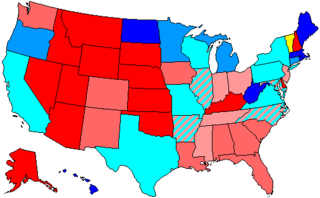105th Congress of the United States
The 105th Congress of the United States , composed of the House and Senate , was the legislature of the United States . Its legislative period lasted from January 3, 1997 to January 3, 1999. All members of the House of Representatives and a third of the senators ( Class II ) were elected on November 5, 1996 in the congressional elections. There was a Republican majority in both chambers . Congress met in the American capital Washington, DC The distribution of seats in the House of Representatives was based on the 1990 census .
Important events
- January 3, 1997: The newly elected Congress begins its work.
- August 7, 1998: Terrorist attacks on the US embassies in Dar es Salaam and Nairobi
- December 19, 1998: Impeachment proceedings against Democratic President Bill Clinton are initiated.
The main laws
During the session of the 105th Congress, the following federal laws were passed ( see also: Legislative procedure ):
- August 5, 1997: Balanced Budget Act of 1997
- August 5, 1997: Taxpayer Relief Act of 1997
- June 9, 1998: Transportation Equity Act for the 21st Century
- July 22, 1998: Internal Revenue Service Restructuring and Reform Act of 1998
- August 7, 1998: Workforce Investment Act of 1998
- October 21, 1998: Children's Online Privacy Protection Act
- October 27, 1998: Copyright Term Extension Act
- October 26, 1998: Digital Millennium Copyright Act
- October 31, 1998: Iraq Liberation Act
Composition according to parties
senate
There were no majority changes during the legislative period
| Political party (Shading shows majority party)
|
Total | |||
|---|---|---|---|---|
| republican | Democrats | Vacant | ||
| End of the 104th Congress | 53 | 47 | 100 | 0 |
| 105th Congress | 55 | 45 | 100 | 0 |
| Final share of the vote | 55% | 45% | ||
| Beginning of the 106th Congress | 55 | 45 | 100 | 0 |
House of Representatives
| Political party (Shading shows majority party)
|
Total | ||||
|---|---|---|---|---|---|
| republican | Democrats | Independent | Vacant | ||
| End of the 104th Congress | 234 | 198 | 1 | 433 | 2 |
| Beginning | 228 | 206 | 1 | 435 | 0 |
| The End | 227 | 207 | |||
| Final share of the vote | 52.2% | 47.6% | 0.2% | ||
| Beginning of the 106th Congress | 223 | 211 | 1 | 435 | 0 |
| Non-voting members | 1 | 4th | 0 | 5 | 0 |
Public officials
House of Representatives
| Office | Surname | |
|---|---|---|
| Speaker of the House of Representatives | Newt Gingrich (R) | |
Leadership of the majority party
| Office | Surname | |
|---|---|---|
| Majority leader | Dick Armey (R) | |
| Majority whip | Tom DeLay (R) | |
Leadership of the minority party
| Office | Surname | |
|---|---|---|
| Minority leader | Dick Gephardt (D) | |
| Minority whip | David E. Bonior (D) | |
senate
| Office | Surname | Term of office | |
|---|---|---|---|
| President of the Senate | Al Gore (D) | ||
| President pro tempore | Strom Thurmond (R) | ||
Leadership of the majority party
| Office | Surname | |
|---|---|---|
| Majority leader | Trent Lott (R) | |
| Majority whip | Don Nickles (R) | |
Leadership of the minority party
| Office | Surname | |
|---|---|---|
| Minority leader | Tom Daschle (D) | |
| Minority whip | Wendell Ford (D) | |
Senate members
See List of Senate Members of the 105th United States Congress
Members of the House of Representatives
The following congressmen represented the interests of their respective states in the 105th Congress:
Members of the House of Representatives who are not entitled to vote:
See also
- List of Senate Members of the 105th Congress of the United States
- Elected to the United States House of Representatives in 1996
Web links
- Congressional Record for the 105th Congress Document Collection ( Project THOMAS of the Library of Congress )
- bioguide.congress.gov (by entering 105 under Year OR Congress: you get a list of the members of the 105th Congress with a link to the official biographies; English)


